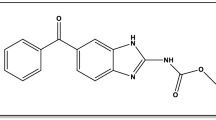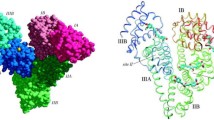Abstract
The interaction between pyridoxine hydrochloride (VB6) and bovine serum albumin (BSA) were studied by spectroscopic methods including fluorescence spectroscopy and UV–visible absorption spectra. The quenching mechanism of fluorescence of BSA by VB6 was discussed. The number of binding sites n and observed binding constant K b was measured by fluorescence quenching method. The thermodynamic parameters ΔH θ, ΔG θ, ΔS θ at different temperatures were calculated and the results indicate the binding reaction is mainly entropy-driven and hydrophobic interaction played major role in the reaction. The distance r between donor (BSA) and acceptor (VB6) was obtained according to FÖrster theory of non-radiation energy transfer. Synchronous fluorescence and three-dimensional fluorescence spectra were used to investigate the structural change of BSA molecules with addition of VB6, the result indicates that the secondary structure of BSA molecules is changed in the presence of VB6.









Similar content being viewed by others
Reference
Kragh-Hansen U (1990) Structure and ligand binding properties of human serum albumin. Dan Med Bull 37:57–84
Cheger SI (1975) Transport function of serum albumin. Buharest, p 178
Purohit G, Sakthivel T, Florence AT (2003) The interaction of cationic dendrons with albumin and their diffusion through cellulose membranes. Int J Pharm 254:37–41
Sudlow G, Birkett DJ, Wade DN (1975) The characterization of two specific drug binding sites on human serum albumin. Mol Pharmacol 11:824–832
Yan CN, Zhang HX, Liu Y, et al (2005) Study on binding reaction between flucytosine and bovine serum albumin. Chin J Chem 23:1151–1156
Angelakou A, Valsami G, Macheras P, et al (1999) A displacement approach for competitive drug-protein binding studies using the potentiometric-anilino-8-naphthalene-sulfonate probe technique. Eur J Pharm Sci 2:123–130
Lakowicz JR (1999) Principle of fluorescence spectroscopy 2nd ed. Plemum Press, New York, p 13
Romanini D, Avalle G, Farruggia B, et al (1998) Spectroscopy features of the binding of polyene antibiotics to human serum albumin. Chem Biol Interact 115:247–260
Sułkowska A, Ro´wnicka J, Bojko B, et al (2003) Interaction of anticancer drugs with human and bovine serum albumin. J Mol Struct 651–653:133–140
Zhang HX, Huang X, Mei P, et al (2006) Studies on the interaction of tricyclazole with β-cyclodextrin and human serum albumin by spectroscopy. J Fluoresc 16(3):287–294
Yan CN, Zhang HX, Liu Y, et al (2005). Fluorescence spectra of the binding reaction between paraquat and bovine serum albumin. Acta Chimi Sin 63:1727–1732
Vaughan WM, Weber G (1970) Oxygen quenching of pyrenebutyric acid fluorescence in water: a dynamic probe of the microenvironment. Biochemistry 9:464–473
Ross DP, Subramanian S (1981) Thermodynamics of protein association reactions: forces contributing to stability. Biochemistry 20:3096–3102
Shaikh SMT, Seetharamappa J, Ashoka S, et al (2007) A study of the interaction between bromopyrogallol red and bovine serum albumin by spectroscopic methods. Dyes Pigments 73:211–216
Hu YJ, Li W, Liu Y, et al (2005) Fluorometric investigation of the interaction between methylene blue and human serum albumin. J Pharm Biomed Anal 39:740–745
Stryer L (1968) Fluorescence spectroscopy of proteins. Science 162:526–533
Saha S, Samanta A (2002) Influence of the structure of amino group and polarity of the medium on the photo physical behavior of 4-amino-1,8-naphthalamide derivatives. J Phys Chem A 106:4763–4771
Gorinstein S, Caspi A, Rosen A (2002) Structure characterization of human serum proteins in solution and dry state. J Pept Res 59:71–78
Forster T (1948) Intermolecular energy migration and fluorescence. Ann Phys 437:55–75
Bapistha M, Indig GL (1998) Effect of BSA binding on photophysical and photochemical properties of triarylmethane dyes. J Phys Chem B 102:4678
Ghosh SK, Hossain SU, Bhattachary S, et al (2005) 2-(2-Selenocyanic acid ethyl ester)-1H-benz[de] isoquinoline-1,3-(2H)-dione, synthesis photophysics and interaction with bovine serum albumin: A spectroscopic approach. J Photochem Photobiol B 81:121–128
Author information
Authors and Affiliations
Corresponding author
Rights and permissions
About this article
Cite this article
Zhang, H., Huang, X. & Zhang, M. Spectral diagnostics of the interaction between pyridoxine hydrochloride and bovine serum albumin in vitro. Mol Biol Rep 35, 699–705 (2008). https://doi.org/10.1007/s11033-007-9143-x
Received:
Accepted:
Published:
Issue Date:
DOI: https://doi.org/10.1007/s11033-007-9143-x




